| A | B |
|---|
What structure is #1 pointing to?,  | .,  |
What structure is #2 pointing to?,  | ., 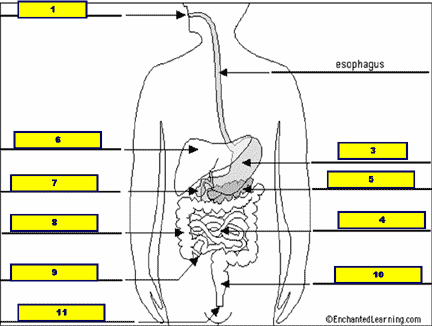 |
What structure is #3 pointing to?,  | ., 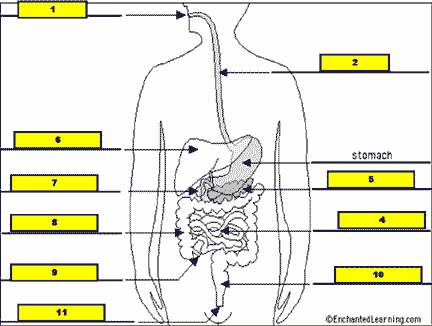 |
What structure is #4 pointing to?,  | ., 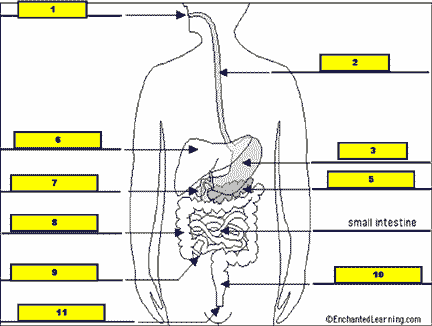 |
What structure is #5 pointing to?,  | ., 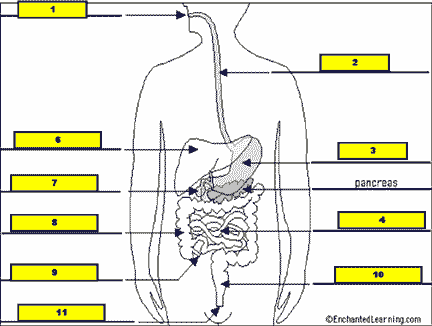 |
What structure is #6 pointing to?,  | .,  |
What structure is #7 pointing to?,  | ., 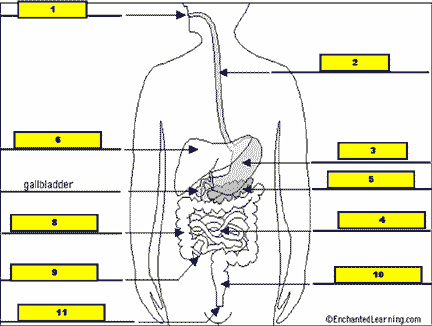 |
What structure is #8 pointing to?,  | ., 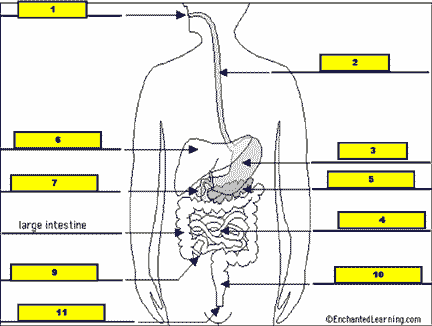 |
What structure is #9 pointing to?,  | ., 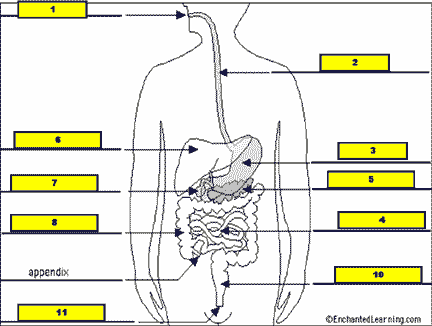 |
What structure is #10 pointing to?,  | .,  |
What structure is #11 pointing to?,  | ., 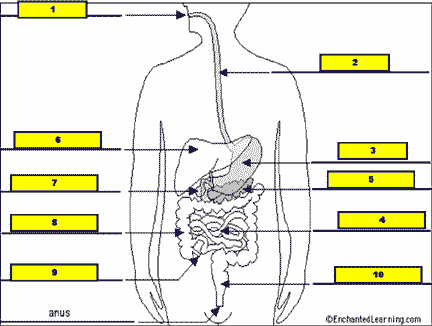 |
| What is the name of the tube that carries food from the mouth to the stomach? | esophagus |
| Which organ produces a substance that helps neutralize stomach acids as they enter the small intestine? | The pancreas |
| Where does chemical digestion of food start? | In the mouth when salivary amylase starts breaking down complex carbohydrates |
| Where does physical digestion of food start? | In the mouth when food is broken into smaller chunks by mastication (chewing) |
| How is food mechanically digested in the stomach? | Strong muscular contractions of the stomach grind the food |
| The stomach breaks down food into a soft partially digested mixture called ____. | chyme |
| The enzyme called amylase breaks down ___. | carbohydrates |
| Water is extracted from undigested food and sent into the bloodstream while the food passes through the ___. | large intestine |
| The stomach breaks down mainly ___. | proteins |
| Lipids are broken down in the ___. | small intestine |
| Carbohydrates are broken down in the ___. | mouth and small intestine |
| Where in the digestive tract do digested foods leave the digestive tract to enter the bloodstream? | small intestine |
| Where do digested foods go after they leave the small intestine? | bloodstream |
| Where does undigested food go after it leaves the small intestine? | large intestine-->rectum-->anus-->out |
| _____ pushes food down your esophagus into your stomach. | Peristalsis (wave-like contractions of the muscles surrounding the esophagus), 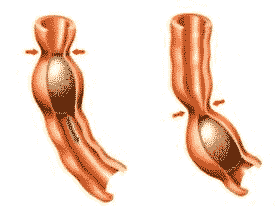 |
| Lipase is an enzyme that breaks down ___. | Lipids (which include fats and oils) |
| Pepsin and peptidase are enzymes that break down ___. | proteins |
| The large organ that lies above the stomach and produces bile is called the ____. | liver |
| ____ is a substance that is produced in the liver and is released by the gall bladder into the small intestine in order to break up fats into smaller droplets. | Bile |
| If part of the stomach wall digests itself, a(n) ___ will develop. | ulcer |
| Stomach juices have a ___ pH and would be described as being ___. | low pH, acidic |
| What are two organs that are part of the digestive system, but not the digestive tract? | Pancreas and liver (food doesn't pass through them. They produce substances that get dumped into the digestive tract to help with digestion), 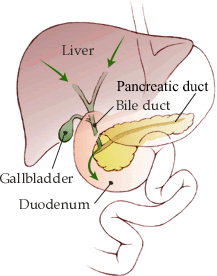 |
| The small fingerlike projections on the inside of the small intestine that help increase absorption of food by increasing the surface area that food comes in contact with are called ___. | Villi and Microvilli, 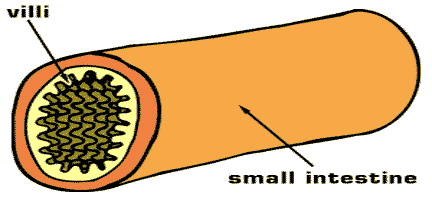 |
| Villi and microvilli are small fingerlike projections on the inside of the small intestine that help increase absorption of food by increasing the ___ that food comes in contact with. | surface area,  |
| In cnidarians (such as hydra) and flatworms (such as a planarium), digestion occurs in a(n) __________ | gastrovascular cavity (has only one opening) |
| Absorption of nutrients in the intestines of an earthworm is enhanced by the presence of a large fold in the upper surface of the intestine called the _______. | typhlosole |
| The area of the digestive tract in which food is mechanically ground up in organisms such as grasshoppers and earthworms is called the ______. | gizzard |
| The digestive tract of humans is about 30 feet long and uses _______ muscles to push food along. | smooth (involuntary) |
| The flap of cartilage in the back of the throat ( _________ ) of humans that keeps food from going down the windpipe is called the ______. | pharynx, epiglottis |
| The mixture of acid and enzymes that is secreted by the cells that line the stomach is called ______. | gastric juice |
| The _______ in the stomach are made up of two types of cells: Parietal cells that releases ____ and chief cells that releases ________. | Gastric pits, HCl, pepsinogen |
| What causes the inactive stomach enzyme pepsinogen to attain the active configuration to become pepsin? | low pH |
| Pepsin breaks down _______ in the _______. | proteins, stomach |
| Mammals contain an enzyme called ______ that is needed to break down __________. | rennin, milk proteins |
| The _______ at the anterior end of the stomach keeps food from backing up the esophagus. | cardiac sphincter |
| The _______ at the posterior end of the stomach keeps food in the stomach long enough to digest. | pyloric sphincter |
| The first 12 inches of the small intestine is called the ______. | Duodenum |
| Bile acts to ______ fats into smaller droplets. | emulsify |
| Enzymes that break down nucleic acids would be called ______. | nucleases |
| A(n) ______ is a small vessel of the lymphatic system that absorbs glycerol and fatty acids from the intestine. | lacteal |
| Another name for the large intestine is the _____. | colon |
| The middle section of the small intestine is called the _____. | jejunum |
| The final part of the small intestine is called the ____. | ileum |
| The process of removing undigested waste is called ______. | egestion |
| ________ is a hormone that stimulates secretion of gastric juices from the stomach wall. | Gastrin |
| _______ is a hormone made in the duodenal wall that stimulates the pancreas to release ______ in order to neutralize acids coming in from the stomach. | Secretin, bicarbonate |
| ________ is a hormone produced in the duodenal wall that stimulates the pancreas to release pancreatic enzymes and the gall bladder to release bile into the small intestine. | Cholecystokinin (CCK) |